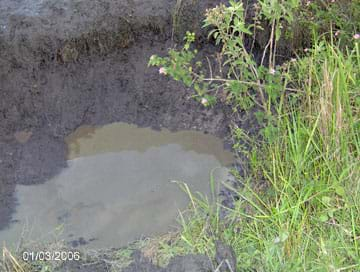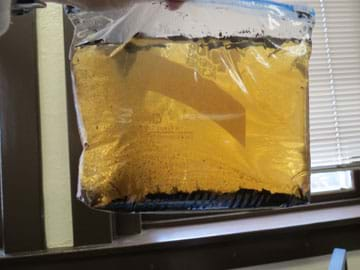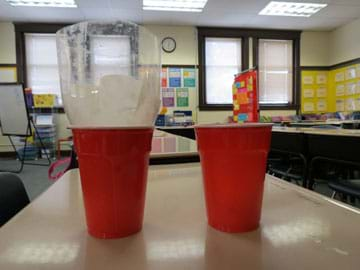Quick Look
Grade Level: 5 (4-6)
Time Required: 1 hour
(Complete Part 1 of this activity. Then, complete Part 2 of the activity three days later.)
Expendable Cost/Group: US $2.00
Group Size: 3
Activity Dependency:
Subject Areas: Chemistry, Earth and Space
NGSS Performance Expectations:

| 3-5-ETS1-1 |
| 5-ESS3-1 |

Summary
Students leach organic matter from soil to create a water sample with high dissolved organic matter content (DOM), and then make filters to see if the DOM can be removed. They experience the difficulties of removing DOM from water, and learn about other processes that might make DOM removal more effective.Engineering Connection
Identifying safe and suitable drinking water sources is an important environmental engineering task to support communities. When identifying potential water sources, engineers always consider the amount of dissolved organic matter (DOM) that is present because DOM can be transformed into varopis dangerous chemicals when exposed to chlorine during the water treatment cleaning process. Before municipal water comes out of a faucet, it goes through several treatment steps to make sure it is safe for human consumption. Engineers design these water treatment processes and facilities.
Learning Objectives
After this activity, students should be able to:
- Explain the process of filtration and its value in treating water.
- Describe the difficulty of removing dissolved organic matter content (DOMC) from water.
Educational Standards
Each TeachEngineering lesson or activity is correlated to one or more K-12 science,
technology, engineering or math (STEM) educational standards.
All 100,000+ K-12 STEM standards covered in TeachEngineering are collected, maintained and packaged by the Achievement Standards Network (ASN),
a project of D2L (www.achievementstandards.org).
In the ASN, standards are hierarchically structured: first by source; e.g., by state; within source by type; e.g., science or mathematics;
within type by subtype, then by grade, etc.
Each TeachEngineering lesson or activity is correlated to one or more K-12 science, technology, engineering or math (STEM) educational standards.
All 100,000+ K-12 STEM standards covered in TeachEngineering are collected, maintained and packaged by the Achievement Standards Network (ASN), a project of D2L (www.achievementstandards.org).
In the ASN, standards are hierarchically structured: first by source; e.g., by state; within source by type; e.g., science or mathematics; within type by subtype, then by grade, etc.
NGSS: Next Generation Science Standards - Science
| NGSS Performance Expectation | ||
|---|---|---|
|
3-5-ETS1-1. Define a simple design problem reflecting a need or a want that includes specified criteria for success and constraints on materials, time, or cost. (Grades 3 - 5) Do you agree with this alignment? |
||
| Click to view other curriculum aligned to this Performance Expectation | ||
| This activity focuses on the following Three Dimensional Learning aspects of NGSS: | ||
| Science & Engineering Practices | Disciplinary Core Ideas | Crosscutting Concepts |
| Define a simple design problem that can be solved through the development of an object, tool, process, or system and includes several criteria for success and constraints on materials, time, or cost. Alignment agreement: | Possible solutions to a problem are limited by available materials and resources (constraints). The success of a designed solution is determined by considering the desired features of a solution (criteria). Different proposals for solutions can be compared on the basis of how well each one meets the specified criteria for success or how well each takes the constraints into account. Alignment agreement: | People's needs and wants change over time, as do their demands for new and improved technologies. Alignment agreement: |
| NGSS Performance Expectation | ||
|---|---|---|
|
5-ESS3-1. Obtain and combine information about ways individual communities use science ideas to protect the Earth's resources and environment. (Grade 5) Do you agree with this alignment? |
||
| Click to view other curriculum aligned to this Performance Expectation | ||
| This activity focuses on the following Three Dimensional Learning aspects of NGSS: | ||
| Science & Engineering Practices | Disciplinary Core Ideas | Crosscutting Concepts |
| Obtain and combine information from books and/or other reliable media to explain phenomena or solutions to a design problem. Alignment agreement: | Human activities in agriculture, industry, and everyday life have had major effects on the land, vegetation, streams, ocean, air, and even outer space. But individuals and communities are doing things to help protect Earth's resources and environments. Alignment agreement: | A system can be described in terms of its components and their interactions. Alignment agreement: Science findings are limited to questions that can be answered with empirical evidence.Alignment agreement: |
International Technology and Engineering Educators Association - Technology
-
Students will develop an understanding of the effects of technology on the environment.
(Grades
K -
12)
More Details
Do you agree with this alignment?
-
Students will develop an understanding of engineering design.
(Grades
K -
12)
More Details
Do you agree with this alignment?
-
Explain how knowledge gained from other content areas affects the development of technological products and systems.
(Grades
6 -
8)
More Details
Do you agree with this alignment?
State Standards
Colorado - Science
-
Develop, communicate, and justify a procedure to separate simple mixtures based on physical properties
(Grade
5)
More Details
Do you agree with this alignment?
-
Identify problems, and propose solutions related to water quality, circulation, and distribution – both locally and worldwide
(Grade
6)
More Details
Do you agree with this alignment?
Materials List
Each group needs:
- top half of a two-liter plastic bottle
- coffee filter
- zip-lock sandwich bag
- 2 plastic cups
- A Matter of Leaching Worksheet, one per student
To share with the entire class:
- sand (approximately 5-10 pounds)
- gravel (approximately 5-10 pounds)
- cotton balls
- screening (one to two 4"x4" squares per group)
- activated charcoal or carbon (optional, can be purchased on amazon.com or at some garden centers)
- garden soil, not potting soil (one handful per group)
- permanent marker
Worksheets and Attachments
Visit [www.teachengineering.org/activities/view/cub_drink_lesson01_activity1] to print or download.Pre-Req Knowledge
A familiarity with dissolved organic matter and a general understanding of conventional drinking water treatment processes, as presented in the associated lesson, All About Water!
Introduction/Motivation
- In this activity, we are going to act like environmental engineers, responsible for delivering clean drinking water to a community. But first, we will make water dirty!
- To make dirty water, we are going to leach organic matter from soil. Does anyone know what a leech is? A leech is a bug that sucks blood, and just like a leech sucks blood, we are going to suck the organic matter from soil! We are leaching organic matter to simulate a natural stream or groundwater drinking source. All natural bodies of water have organic matter in them—it's just the amount that differs.
- Our simulation will be helpful in showing the hardships of cleaning water that contains high organic matter content. You will each be given a plastic bag and will put soil and water in the bag and let it sit for several days. After the water is nice and dirty, you will design and build water filters and see how clean you can get the water!
Procedure
Background
Students leach organic matter from soil and create water samples with high DOM content by soaking dirt in water. They design and build water filters by layering sand, gravel, cotton balls, screening, activated charcoal and/or soil inside the tops of two-liter bottles. After the water sits for three days, students test to see how effective their filters are at cleaning the dirty water. Then they rebuild their filters to make improvements, and reflect on their designs.
Before the Activity
- Gather materials.
- Cut the two-liter bottles in half.
- Make copies of the attached A Matter of Leaching Worksheet, one per student.
- Divide the class into groups of three or four students.
With the Students
Part 1: Leaching Organic Matter
- Distribute the worksheets.
- Give each group a zip-lock sandwich bag that contains a handful of soil. Have students write their names on their bags in permanent marker.
- Instruct students to make observations about their soil. Prompt students to notice texture, smell and color.
- Fill each bag with warm water until it is approximately three quarters full (see Figure 1).
- Let the bags sit with no disruption for a minimum of three days.

Part 2: Filtering
- Hand bags back out to students (without shaking).
- Have students make new observations about the contents of their bags. Instruct students to write about their observations on their worksheets.
- Give each student a top half of a two-liter bottle. Pass out one coffee filter to each group, and have students insert the coffee filters into their two-liter bottles tops (see Figure 2).
- List the following materials on the board: sand, gravel, cotton balls, screening, activated charcoal or carbon, and soil. Tell students that their challenge is to work as engineers to make filter that effectively clean the water. They can use any of the materials listed on the board to put onto the coffee filter inside their two-liter bottles tops.
- Have students brainstorm and then sketch filter designs on their worksheets. Their sketches should show the various layers of materials they are going to use. Have students show their designs to the teacher and explain why they think their designs will work.
- Hand out materials and give students time to create their filters.
- After all groups have built their designs, begin testing the filters. Give two plastic cups to each group. Instruct each group to take their bag of dirty water and pour most of it into one of the plastic cups; hold back a bit of the dirty water as a control for final comparison).

- Have students insert their two-liter bottles and coffee filters into the second, dry cup (see Figure 2). Then, instruct them to pour the dirty water from the first cup into the top of the two-liter bottle, their filter system. Note that, depending on the materials students choose to use for their filters, it might take a good deal of time for the water to exit the filter.
- Have students run the water through their filters three times, each time moving the filtering apparatus onto the empty cup and pouring the excess water on top of the filter.
- Expect students to be able to see a difference between their initial water samples and the final products. Prompt students to think about how well their filters worked. Would you drink this water?
- Have students redesign their filters based on what they've learned so far. Then, instruct them to filter their cleaner water with their improved filtering apparatus two times. Now, students have their final products.
- Have students make observations about their filtered water and write notes on their worksheets. Have students compare their before and after products.
- Compare final products between groups and prompt students to think about why some designs worked better than others. (Expect filters with the most sand and gravel to be the most effective. The longer it takes the water to flow through the filter, the cleaner it will be, due to the fact that the water had more contact time.)
Vocabulary/Definitions
filter: A porous material through which water can pass in order to strain out suspended solids.
filtration: The process of passing through a filter.
leach: Putting water through a sample to remove some constituents.
Assessment
Pre-Activity Assessment
In-Class Questions: Can anyone list the materials used in a drinking water treatment plant filter? (Answer: Sand, gravel and activated charcoal.) How do these materials compare to what we have in class today? (You may not have all the same materials, but you can ask students what they think each of the materials helps with.)
Activity Embedded Assessment
Questioning Designs: When students have finished their designs, have them discuss the pros and cons within their groups to decide on a final design. Circulate around the classroom to listen in on the discussions. When students present their final designs, have them explain their reasoning. Ask questions such as: Why did you decide to place the sand at the top (or other location) of your filter? Do you think that it was a good decision to omit gravel (or another material)? Why?
Worksheet: During the activity, have students complete their worksheets.
Post-Activity Assessment
Reflection: Have one student from each group bring its final water sample to the front of the room. Instruct students to rank water samples from cleanest to dirtiest (explain that they are just basing this off of visual observations, and that many of the solids have been removed from the water samples, but that does not mean the water is really "clean"). Have the groups ranked first and last explain their filter designs, describing how they were made and the order of the materials. Guide students talk about the differences in their filters and decide which materials worked best. Discuss why the dissolved organic matter was not removed very well. (Due to the lack of activated charcoal in the designs, no chemical reactions take place with the DOM. The DOM cannot be filtered out with the students' methods because the molecules are so small. However, they probably did a pretty good job of removing many of the suspended solids!)
Troubleshooting Tips
- Thoroughly wet the sand before making it available for filter building. If the sand is too dry, it absorbs the water instead of filtering it through.
- The more sand in the design, the longer it takes to filter, so limit the amount of sand that students are permitted to use if testing time is limited.
- Make sure the bags of soil and water are sealed tightly and stored in upright positions in order to prevent any spills and messes.
- Do not let students drink their filtered water! Explain that even though the water may look clean, dissolved organic matter still exists in the water and it is not safe to drink. In a real water treatment process, the water would go through many more purification steps before it would be safe for consumption.
Subscribe
Get the inside scoop on all things TeachEngineering such as new site features, curriculum updates, video releases, and more by signing up for our newsletter!More Curriculum Like This

Students learn about the differences between water source types (surface and ground) as well as the differences between streams, rivers and lakes. Then, they learn about dissolved organic matter (DOM) and the role it plays in identifying drinking water sources.
Copyright
© 2012 by Regents of the University of Colorado.Contributors
Jessica Ebert; Marissa H. ForbesSupporting Program
Integrated Teaching and Learning Program, College of Engineering and Applied Science, University of Colorado BoulderAcknowledgements
This digital library content was developed by the Integrated Teaching and Learning Program under National Science Foundation GK-12 grant no. DGE 0338326. However, these contents do not necessarily represent the policies of the National Science Foundation, and you should not assume endorsement by the federal government.
Last modified: April 2, 2019







User Comments & Tips